Renovating a bathroom involves careful consideration of plumbing expenses, which can range from a few hundred to several thousand dollars based on project complexity. Fixture pricing also varies significantly, with costs influenced by quality and brand, typically falling between a few hundred to several thousand dollars. Additionally, homeowners have a wealth of design options to explore, allowing them to tailor their bathroom to their unique style and functional needs.
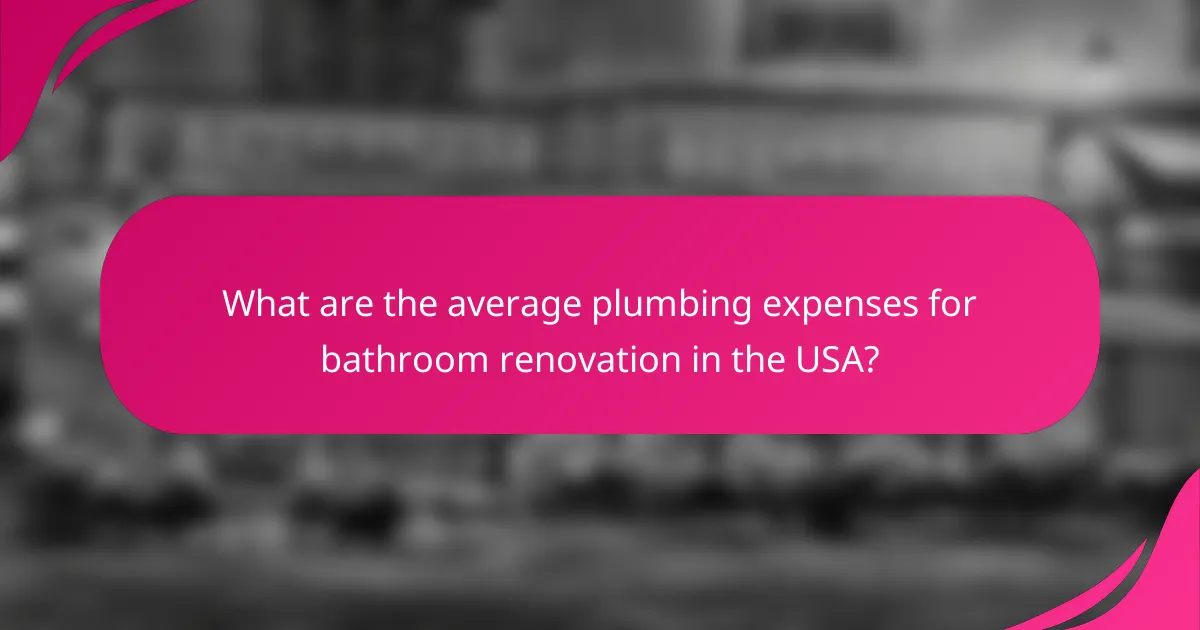
What are the average plumbing expenses for bathroom renovation in the USA?
The average plumbing expenses for bathroom renovation in the USA typically range from a few hundred to several thousand dollars, depending on the complexity of the project. Key factors include labor costs, materials, and specific design choices.
Cost range for plumbing labor
Plumbing labor costs can vary significantly, generally falling between $45 and $200 per hour. For a complete bathroom renovation, labor might total anywhere from $1,000 to $3,000, depending on the scope of work and local wage rates.
Complex tasks, such as relocating plumbing fixtures or installing new systems, will increase labor costs. It’s advisable to obtain multiple quotes from licensed plumbers to ensure competitive pricing.
Average material costs for plumbing
Material costs for plumbing in a bathroom renovation typically range from $500 to $2,500. This includes pipes, fittings, fixtures, and other necessary supplies. Basic materials like PVC pipes are less expensive, while high-end fixtures can significantly increase overall costs.
When budgeting, consider the quality of materials, as investing in durable options can save money on repairs in the long run. Always check for warranties and certifications to ensure compliance with local standards.
Factors affecting plumbing expenses
Several factors can influence plumbing expenses during a bathroom renovation. The complexity of the plumbing layout, the type of fixtures chosen, and any necessary upgrades to existing systems can all impact costs.
Additionally, geographic location plays a crucial role; urban areas often have higher labor rates compared to rural locations. It’s essential to plan your renovation carefully, as unexpected issues like outdated plumbing codes or hidden damage can lead to increased expenses.
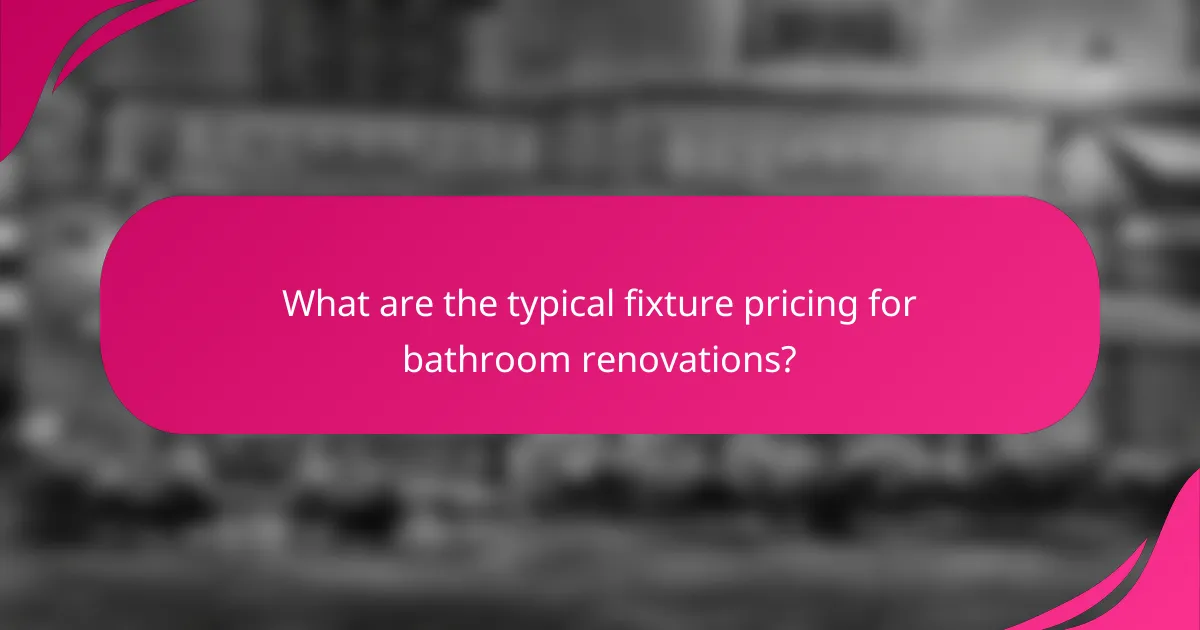
What are the typical fixture pricing for bathroom renovations?
Fixture pricing for bathroom renovations varies widely based on quality, brand, and style. Generally, homeowners can expect to spend anywhere from a few hundred to several thousand dollars on fixtures, depending on their choices and preferences.
Average costs for sinks and faucets
The cost of sinks and faucets can range significantly. Basic models may start around $50 for a sink and $30 for a faucet, while high-end options can exceed $1,000 each. Consider the material and design; for instance, ceramic sinks are often more affordable than stone or custom designs.
Installation costs should also be factored in, which can add another $100 to $300 depending on plumbing complexity. Always check for compatibility with existing plumbing to avoid unexpected expenses.
Shower and bathtub pricing
Shower and bathtub pricing varies based on type and features. A standard bathtub can cost between $200 and $1,500, while custom or luxury models may reach $5,000 or more. Showers, including enclosures and fixtures, typically range from $500 to $3,000.
When selecting a shower or bathtub, consider the space available and the installation requirements. Custom installations may incur higher labor costs, so it’s wise to get multiple quotes from contractors.
Toilet price ranges
Toilet prices generally fall between $100 and $1,000, depending on the model and features such as water efficiency and design. Basic models are often the most affordable, while high-efficiency or smart toilets can be significantly pricier.
Installation costs for toilets can add another $150 to $300. Ensure that the toilet you choose meets local plumbing codes and fits your bathroom’s layout to avoid additional modifications.
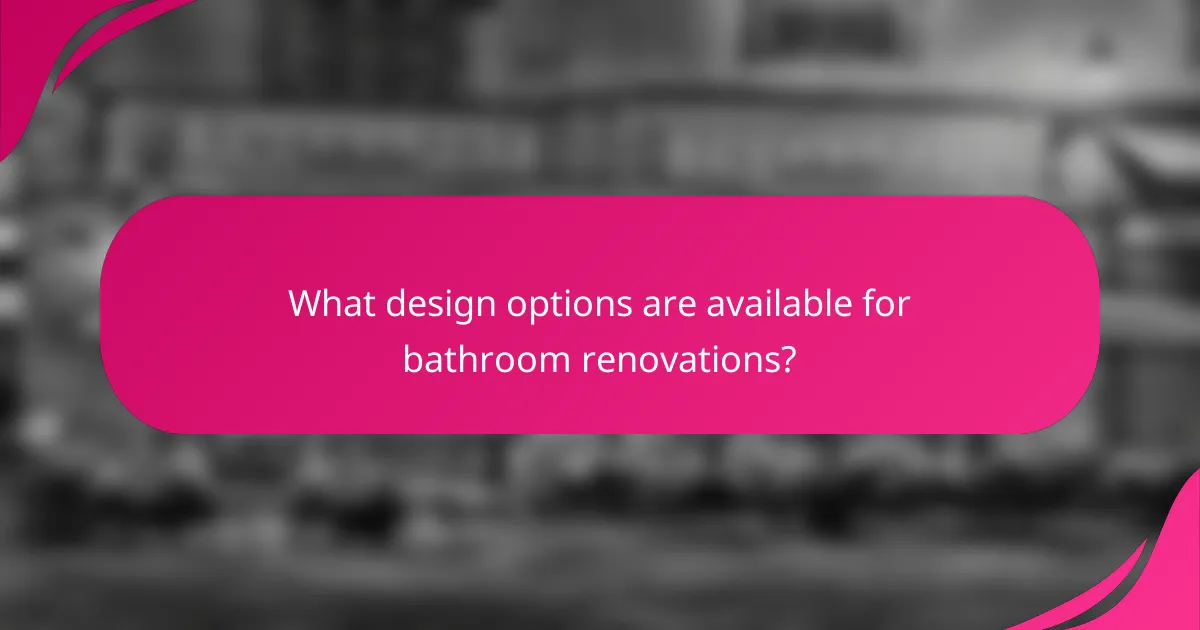
What design options are available for bathroom renovations?
Bathroom renovations offer a variety of design options that cater to different styles, preferences, and functional needs. Homeowners can choose from modern or traditional aesthetics, various color schemes, and innovative space-saving solutions to create a personalized and efficient bathroom environment.
Popular design styles (modern, traditional)
Modern bathroom design typically features clean lines, minimalistic fixtures, and a neutral color palette, often incorporating materials like glass and chrome. This style emphasizes functionality and simplicity, making it ideal for smaller spaces.
In contrast, traditional bathrooms often showcase ornate details, classic fixtures, and warm colors. Features such as clawfoot tubs and pedestal sinks are common, creating a timeless and inviting atmosphere. When choosing a style, consider the overall theme of your home to ensure cohesion.
Color schemes and materials
Color schemes play a crucial role in bathroom design, influencing the mood and perceived size of the space. Light colors, such as whites and pastels, can make a small bathroom feel larger, while darker hues can add depth and sophistication.
Materials also significantly impact the look and durability of your bathroom. Popular choices include ceramic tiles for flooring and walls, quartz or granite for countertops, and stainless steel for fixtures. Selecting high-quality materials can enhance both aesthetics and longevity.
Space-saving solutions
Space-saving solutions are essential in smaller bathrooms to maximize functionality without sacrificing style. Consider wall-mounted sinks and toilets, which free up floor space and create a more open feel.
Additionally, built-in storage options, such as recessed shelves or cabinetry, can help keep the bathroom organized and clutter-free. Using mirrors strategically can also create an illusion of more space, making the bathroom feel larger and brighter.
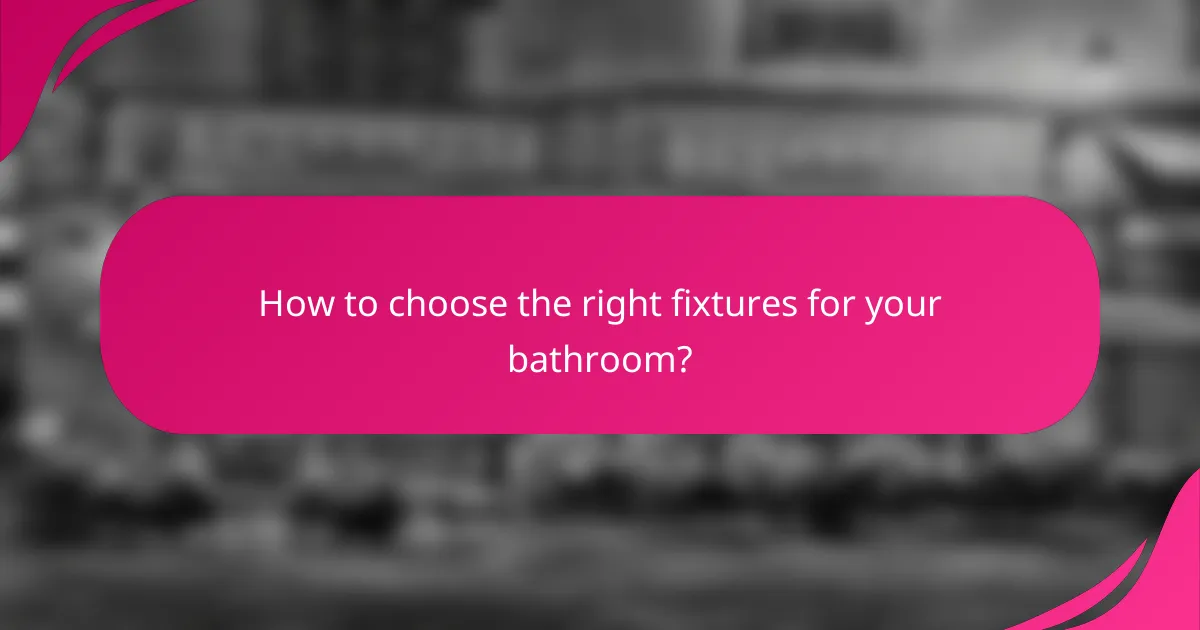
How to choose the right fixtures for your bathroom?
Choosing the right fixtures for your bathroom involves considering functionality, style, and budget. Focus on quality and compatibility with your existing plumbing to ensure a seamless renovation.
Considerations for fixture selection
When selecting bathroom fixtures, prioritize the size and layout of your space. Measure the area to ensure that the fixtures fit comfortably without overcrowding. Additionally, consider the water efficiency of faucets and toilets, as this can significantly impact your water bill.
Think about the overall design theme you want to achieve. Whether you prefer a modern, minimalist look or a more traditional style, the fixtures should complement the aesthetic. Choose materials that are durable and easy to maintain, such as stainless steel or ceramic.
Brand recommendations for quality
For reliable bathroom fixtures, consider brands like Kohler, Moen, and Delta, known for their durability and innovative designs. These brands often offer a wide range of styles and finishes to match your bathroom decor.
Additionally, check for warranties and customer reviews before making a purchase. Brands that provide good customer service and support can save you time and money in the long run, especially if you encounter issues with installation or functionality.
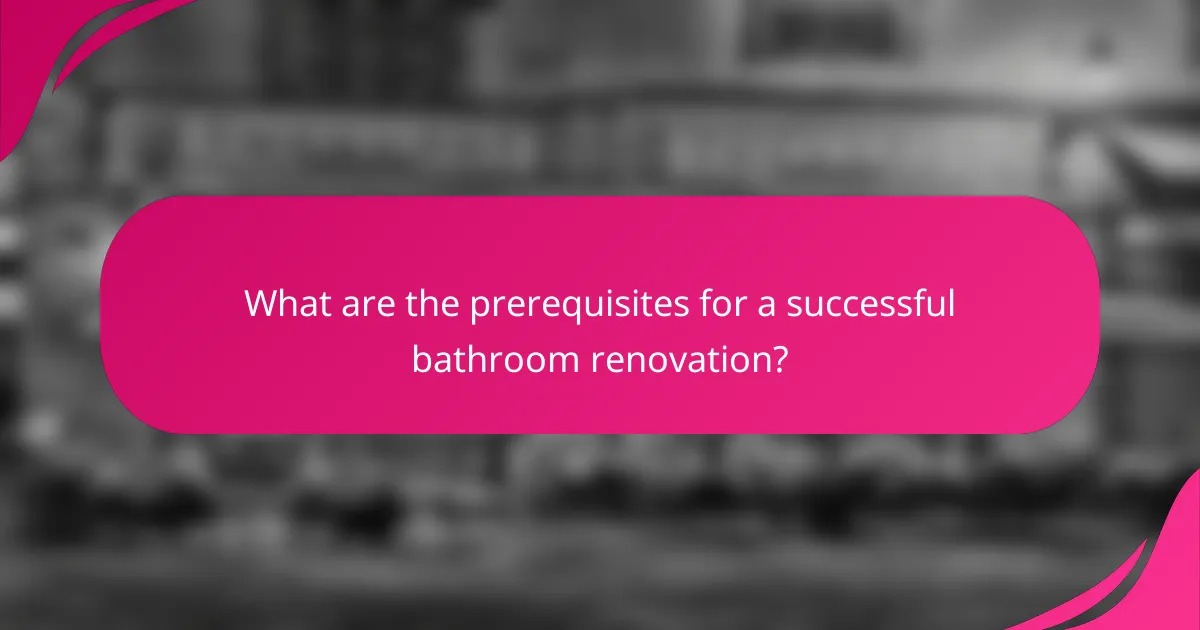
What are the prerequisites for a successful bathroom renovation?
A successful bathroom renovation requires careful planning, a clear budget, and an understanding of local regulations. By addressing these factors upfront, homeowners can avoid common pitfalls and ensure a smoother renovation process.
Planning and budgeting steps
Start by defining your renovation goals, whether it’s updating fixtures, improving functionality, or enhancing aesthetics. Create a detailed budget that includes costs for plumbing, fixtures, materials, and labor, typically ranging from a few thousand to tens of thousands of dollars depending on the scope.
Consider prioritizing your spending by identifying essential upgrades versus optional enhancements. For example, investing in quality plumbing may save future costs, while luxury fixtures can be added later if the budget allows.
Permits and regulations in major cities
Before starting a renovation, check if your city requires permits for plumbing or structural changes. Regulations can vary significantly; for instance, cities like New York and Los Angeles have strict codes that must be followed to ensure safety and compliance.
Familiarize yourself with local building codes and zoning laws, which can affect everything from the placement of fixtures to plumbing requirements. Engaging a licensed contractor familiar with these regulations can help navigate the complexities and avoid costly fines.

What are the emerging trends in bathroom renovation?
Emerging trends in bathroom renovation focus on sustainability, technology integration, and personalized design. Homeowners are increasingly prioritizing eco-friendly materials and smart devices that enhance functionality and efficiency.
Sustainable materials and fixtures
Sustainable materials and fixtures are becoming essential in bathroom renovations. Options like bamboo, recycled glass, and low-VOC paints not only reduce environmental impact but also add unique aesthetics. Choosing water-efficient fixtures can significantly lower water usage, which is both eco-friendly and cost-effective.
When selecting sustainable options, consider certifications such as Energy Star or WaterSense. These labels indicate products that meet strict efficiency guidelines, helping you make informed choices that align with your sustainability goals.
Smart bathroom technology
Smart bathroom technology is revolutionizing how we use and interact with our bathrooms. Features like smart showers, automated lighting, and voice-activated faucets enhance convenience and can improve energy efficiency. These technologies often allow for customizable settings, catering to individual preferences.
Investing in smart technology can involve upfront costs, but the long-term savings on water and energy bills can offset these expenses. Look for products that integrate with existing home automation systems for seamless operation and enhanced functionality.
